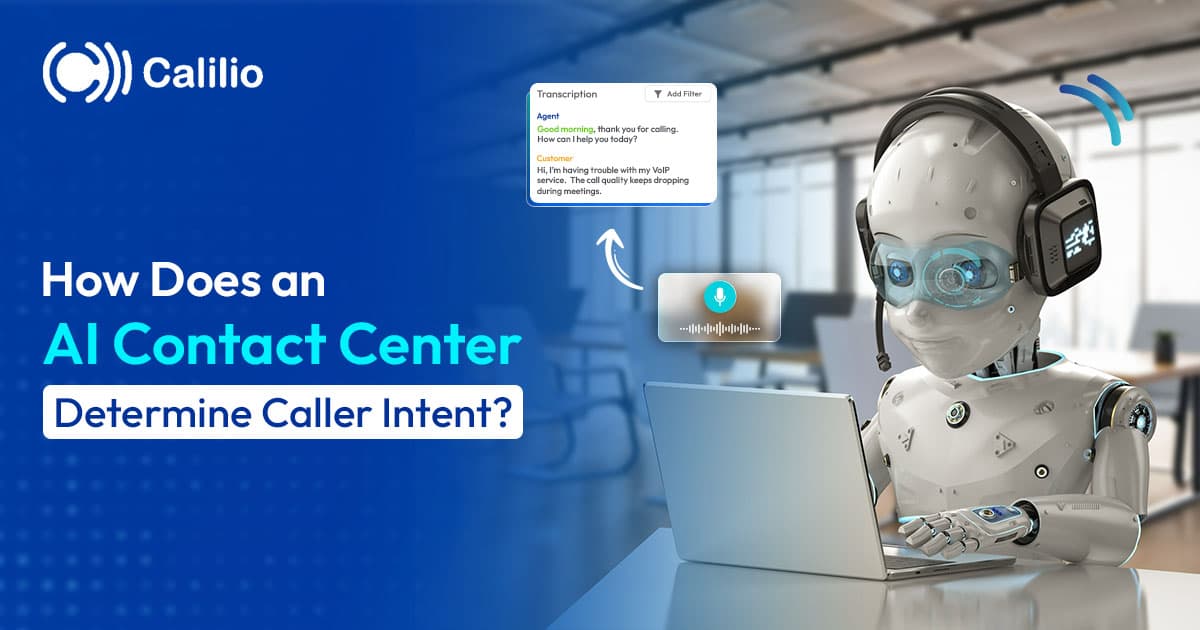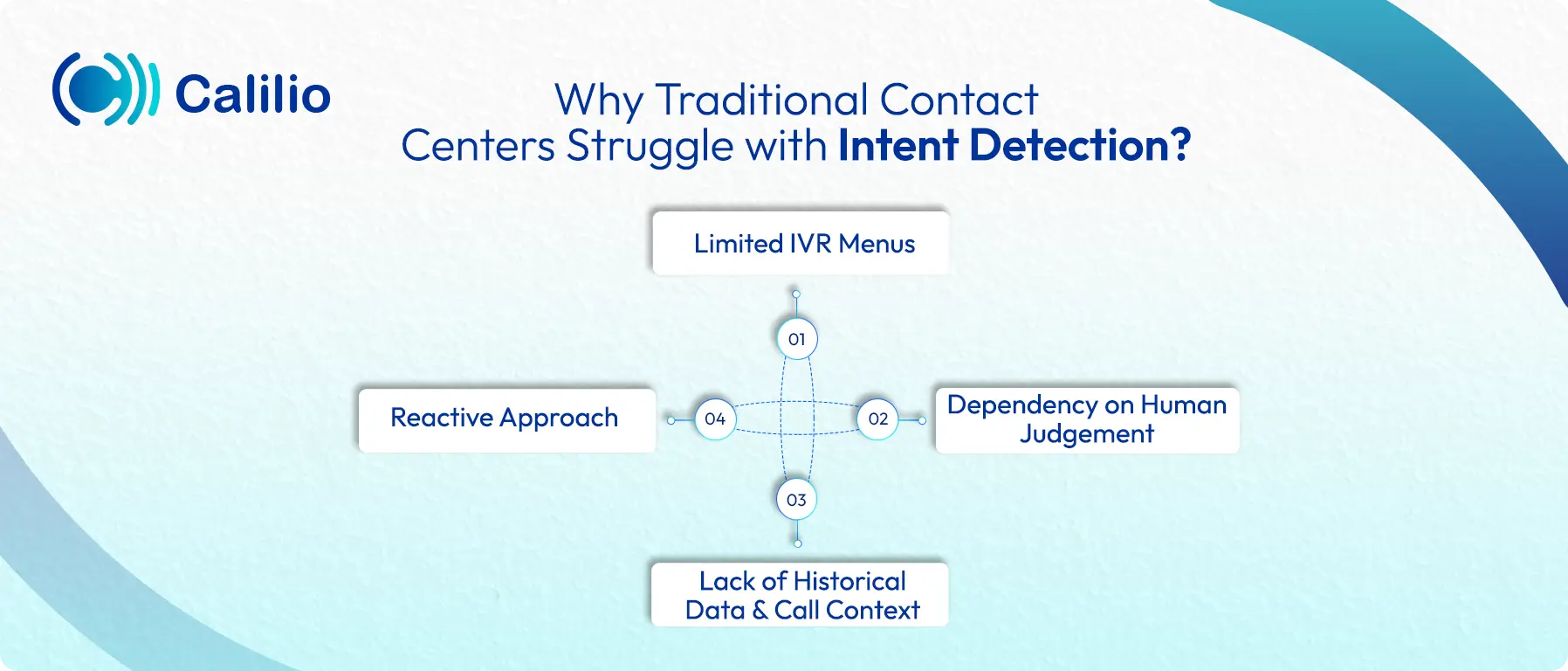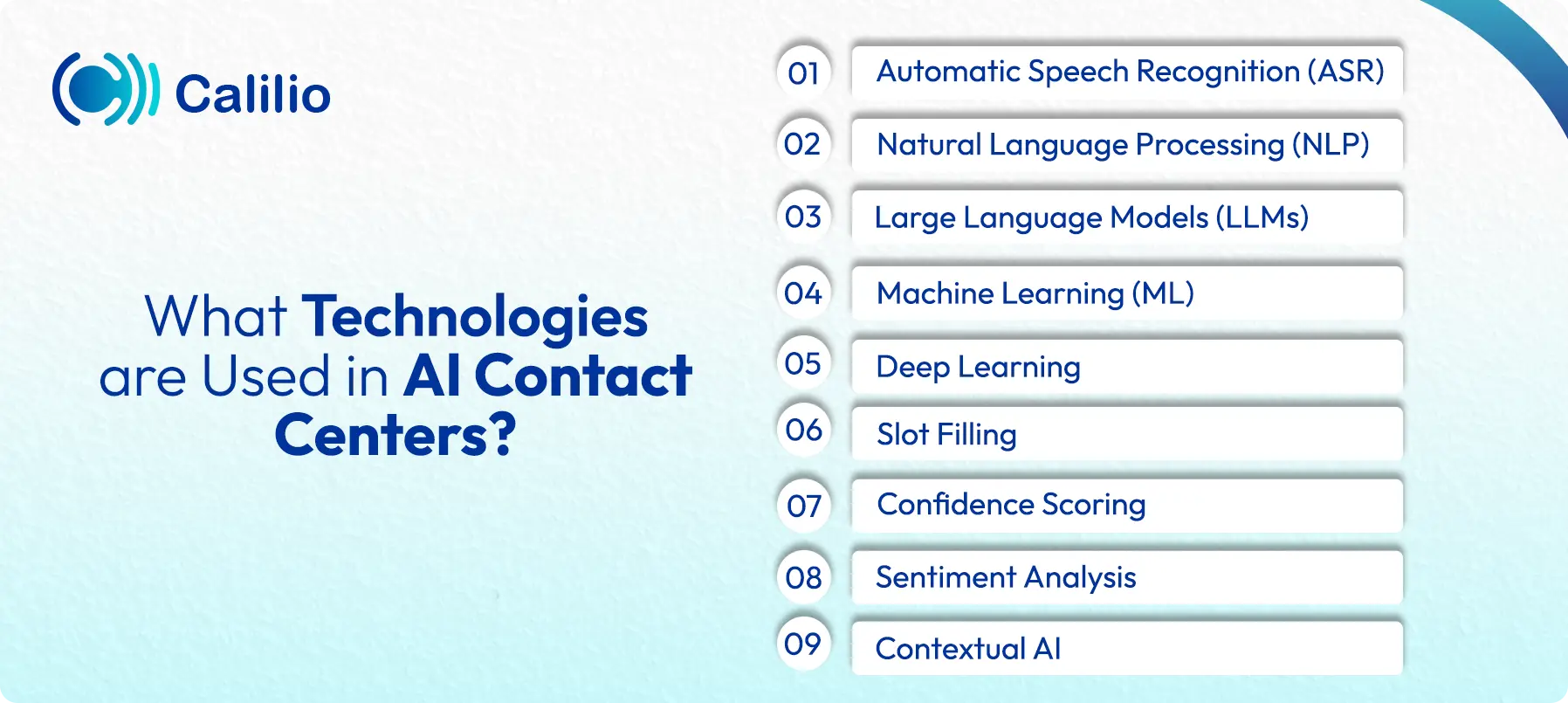AI Contact Center: How It Detects Caller Intent in Real Time

Every business call has a clear purpose. A customer may be seeking quick support, asking about a product, or reporting a problem. Yet traditional contact centers often fail to recognize caller intent. Agents work with limited information, leading to longer wait times, repeated explanations, and creating frustration.
The simple solution to this is an AI contact center. From the moment a call begins, the system analyzes speech, identifies keywords, and detects tone. Within seconds, it understands why the customer is calling and routes the call to the right place, ensuring faster and more accurate support.
In this article, we’ll explain how an AI contact center determines caller intent, what technologies make it possible, and why it’s becoming essential for modern businesses.
Key Highlights:
Caller intent explains why customers contact a business, such as requesting product information, seeking support, following up on an order, or raising a complaint.
An AI contact center determines caller intent in real time by using Automatic Speech Recognition (ASR), Natural Language Processing (NLP), Machine Learning (ML), and contextual analysis.
AI faces challenges with strong accents, noisy environments, vague queries, and limited training data, but it improves accuracy as it learns from more interactions.
Businesses in e-commerce, banking, healthcare, insurance, telecom, travel, education, real estate, and SaaS already use AI to detect caller intent.
Businesses should consider automation features, real-time intent detection, CRM integration, scalability, reporting tools, and strong data security when choosing an AI contact center.
What is Caller Intent in a Contact Center?
Caller intent in a contact center refers to the reason behind a customer’s call. It explains what the customer wants to achieve when reaching out to a business. This could range from requesting product information, seeking technical support, following up on an order, or raising a complaint.
Accurately identifying caller intent is essential because it sets the direction for the entire interaction. When businesses understand why a customer is calling, they can connect them to the right agent, provide faster solutions, and deliver a more personalized experience.
Why Traditional Contact Centers Struggle with Intent Detection?
Traditional contact centers often struggle with caller intent detection due to limited IVR (Interactive Voice Response) menus, a lack of contextual data, and the reliance on human judgment.

- Limited IVR Menus: Most traditional contact centers depend on automated menus to route incoming calls. While they help to some extent, they offer limited options and often fail to capture the real reason behind the call. As a result, customers often end up in the wrong department.
- Dependency on Human Judgement: With the traditional approach, the agent must interpret the caller's intent during conversations, which often leads to misrouting, especially if the customer does not explain their problems clearly.
- Lack of Historical Data and Call Context: Traditional systems rarely provide detailed call history. Without access to past interactions, agents handle each call as if it were new. This forces customers to repeat information, which slows down problem-solving.
- Reactive Approach: Traditional contact centers mostly follow the reactive approach. So, caller intent is often identified only after the call begins. This prevents efficient routing and creates inconsistent customer experiences.
How an AI Contact Center Determines Caller Intent in Real-Time?
To identify caller intent, an AI contact center first converts speech into text and analyzes language. Then, it classifies intent, adds context, and takes the right action. This real-time process ensures faster, more accurate, and personalized customer service.
1. Convert Speech to Text
The process starts as soon as the caller begins speaking. The Automatic Speech Recognition (ASR) technology converts spoken languages into a text transcript in real-time. It also manages background noise, filters words, and notes speaking styles, ensuring text is accurate enough for deeper insights.
2. Analyze the Text
Once the speech is transcribed, the Natural Language Processing (NLP) breaks sentences into parts, understands context, and interprets meaning. It allows AI to interpret slang, cultural expressions, and vague language. Advanced Large Language Models (LLMs) make this even more effective, as they are trained to recognize intent across many different ways of phrasing a request.
3. Classify the Intent
After analyzing the language, the system applies Machine Learning (ML) classification. ML models categorize the request into a predefined intent, such as billing, technical support, or sales. They also extract key details or slots, such as dates, locations, or product names.
To ensure accuracy, the AI assigns a confidence score to each prediction. If the score is low, the system may ask clarifying questions or transfer the call to a human agent.
4. Add Extra Context
To improve accuracy further, the AI incorporates additional context:
- Sentiment analysis detects emotions like urgency, frustration, or satisfaction.
- Historical data includes past purchases, previous support tickets, or account information.
- Cross-channel data such as emails, chats, or website activity adds further context, creating a 360-degree view of the customer’s intent.
5. Take Action
Finally, the AI takes appropriate action:
- For simple queries, it may resolve the request instantly through self-service.
- For complex issues, it performs intelligent routing, sending the call to the most qualified agent based on the detected intent, emotional tone, or required expertise.
- If routed to an agent, the AI provides real-time support, such as a call summary, recommended answers, or knowledge base articles, so the agent can resolve the issue faster.
What Technologies are Used in AI Contact Centers?
AI contact centers rely on advanced technologies to understand caller intent with speed and accuracy. Tools include speech recognition, Natural Language Processing, Machine Learning, contextual AI, and more that work together to understand conversations, detect meaning, and guide the next best action.
- Automatic Speech Recognition (ASR): Converts a caller’s spoken words into written text so AI can analyze the conversation.
- Natural Language Processing (NLP): NLP helps AI understand the meaning of the text, including context, grammar, and phrasing.
- Large Language Models (LLMs): Advanced AI models that allow systems to recognize intent even when customers use different words or slang.
- Machine Learning (ML): ML uses patterns from past conversations to identify intent and improves accuracy as it processes more data.
- Deep Learning: A type of ML that uses neural networks to handle complex tasks like recognizing accents or natural speech patterns.
- Slot Filling: It identifies important details in a conversation, such as names, dates, locations, or product information.
- Confidence Scoring: Shows how certain the AI is about its guess of the caller's intent, guiding whether it should act automatically or involve an agent.
- Sentiment Analysis: Examines the caller’s words, tone, and voice to understand their overall attitude, whether it is positive, negative, or neutral.
- Contextual AI: Uses past interactions, account history, or other background data to better predict the caller’s true intent.
What are the Benefits of AI-based Intent Detection?
AI-based intent detection helps businesses manage calls more effectively by identifying the purpose of each call in real time. It enables faster routing, improves customer experience, personalizes interactions, lowers costs, provides actionable insights, and scales easily to meet growing demand.
- Instant Call Routing: AI quickly identifies the purpose of the call and directs it to the most appropriate agent or department, reducing long wait times and unnecessary call transfers.
- Improved Customer Experience: Customers spend less time explaining their issue or being passed around. With AI intent detection, they get faster, more accurate responses, which leads to higher client satisfaction.
- Personalized Experience: AI analyzes context, history, and tone to guide agents. This helps agents tailor their responses to each customer, creating a more personal experience.
- Lower Operational Cost: With faster handling and fewer errors, businesses can manage more calls with the same resources, reducing workload on agents and lowering overall costs.
- Data-Driven Insights: Caller intent detection provides managers with detailed reports on why customers are calling. This helps to fix customer issues, improve products and adjust strategies more efficiently.
- Scalability: Unlike manual systems, AI can handle thousands of calls at the same time with consistent accuracy, making them ideal for businesses with high or fluctuating call volumes.
Limitations of Using AI for Caller Intent Detection
While AI improves accuracy and efficiency in contact centers, it is not flawless. Challenges such as accents, background noise, vague queries, slang, and reliance on training data can affect performance. In complex cases, AI still depends on human agents for reliable support.
- Accents and Speech Styles: AI can misinterpret words when callers speak with strong accents or unusual pronunciation.
- Background Noise: Calls made in noisy environments reduce the accuracy of speech recognition.
- Unclear or Mixed Queries: When customers ask multiple questions at once or describe issues vaguely, AI may struggle to classify the intent correctly.
- Slang and New Phrases: Informal language or region-specific expressions are not always recognized.
- Dependency on Training Data: Accuracy depends on the quality and diversity of the data used to train the system.
- Human Backup Needed: In complex or uncertain cases, AI still requires human agents to step in and handle the interaction.
Use Cases: Industries that Use AI to Detect Caller Intent
AI detects caller intent in industries like e-commerce, banking, insurance, healthcare, telecommunications, travel, government, education, real estate, and technology. With AI, these sectors reduce wait times, improve service, and create smoother customer experiences.

- E-Commerce & Retail: For order tracking, returns, product inquiries, and personalized shopping support.
- Banking & Finance: To manage account services, fraud detection, loan inquiries, and payment issues.
- Insurance: For policy updates, claims processing, and premium-related queries.
- Healthcare: To handle appointment scheduling, prescription refills, and urgent patient requests.
- Telecommunications: For billing assistance, technical support, and service plan changes.
- Travel & Hospitality: To manage bookings, cancellations, flight or hotel updates, and travel assistance.
- Government Services: For citizen support with permits, benefits, tax-related queries, and public program information.
- Education: To assist with admissions, course enrollment, exam schedules, and student support services.
- Real Estate & Property Management: To streamline tenant support, maintenance requests, and property inquiries.
- Technology & SaaS: For software troubleshooting, subscription management, and product support.
What to Look for in an AI Contact Center Platform?
Before choosing an AI contact center platform, look for key features like chatbots, advanced routing, and real-time agent support. Make sure the system integrates with your current tools, handles growth, protects customer data, and offers clear reporting. Also, check if it's easy to use and comes with proper training and support.
- AI & Automation Features: Look for a platform that offers chatbots, advanced call routing, predictive analytics to forecast demand, and agent assist tools for real-time support.
- Integration & Infrastructure: Choose solutions that integrate smoothly with CRM and business tools. Opt for cloud-based systems, as they scale easily and process large data volumes efficiently.
- Scalability and Flexibility: Select a system that can manage higher call volumes as your business grows and adapt to new features or changing customer needs.
- Security and Compliance: Always look for a system with strong encryption, secure access controls, and compliance with regulations such as GDPR or HIPAA.
- Analytics and Reporting: Choose a telephony provider that offers detailed dashboards and reports on customer intents, call patterns, and agent performance.
- User Experience and Training: Opt for an intuitive interface that makes work easier for agents, and ensure the vendor offers proper training and ongoing support.
Final Thoughts
Caller intent shapes every customer interaction, but traditional contact centers often identify it too late, causing delays and frustration. AI contact centers solve this by detecting intent in real time with speech recognition, NLP, and machine learning.
The result is faster resolutions, accurate routing, lower costs, and stronger customer relationships. As expectations rise, AI-driven intent detection is quickly becoming the standard for modern contact centers.

Get Cashbacks Up to 43% Straight To Your Wallet!
Unlimited Virtual Numbers – Local, Mobile & Toll-Free from 100+ Countries
Free Local Phone Number from US or Canada
Crystal-Clear Calls Starting at Just $0.0153/min
24/7 Human Support – Because Great Service Never Takes a Holiday


Frequently Asked Questions
How accurate is AI in understanding caller intent?
AI can detect caller intent with high accuracy when trained on quality data. It uses speech recognition, natural language processing, and machine learning to understand what customers mean, not just what they say. Accuracy may drop in cases of strong accents, noisy calls, or vague requests, but AI improves continuously as it processes more interactions.
Can AI detect multiple intents in a single call?
How does AI intent detection improve agent performance?
Does AI intent detection work across different channels?

Still have questions?
Can’t find the answer you’re looking for? Please chat with our friendly team.
Stay in the loop
Get the latest call insights, trends, and updates delivered straight to your inbox.
By subscribing, you agree to receive updates from Calilio.
You can unsubscribe anytime.